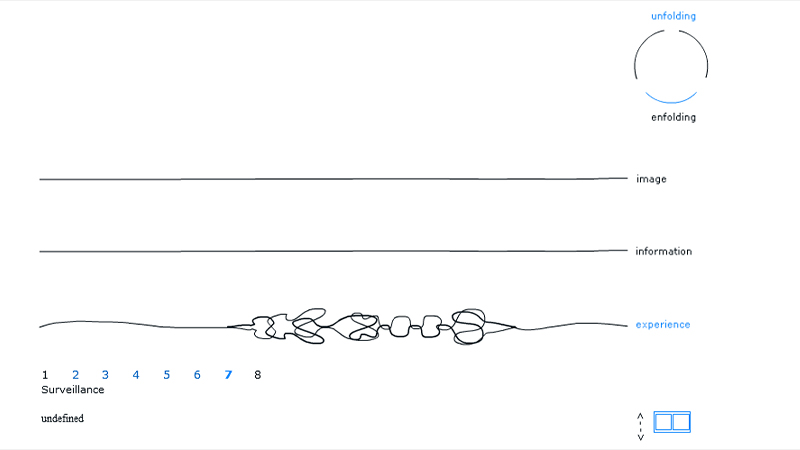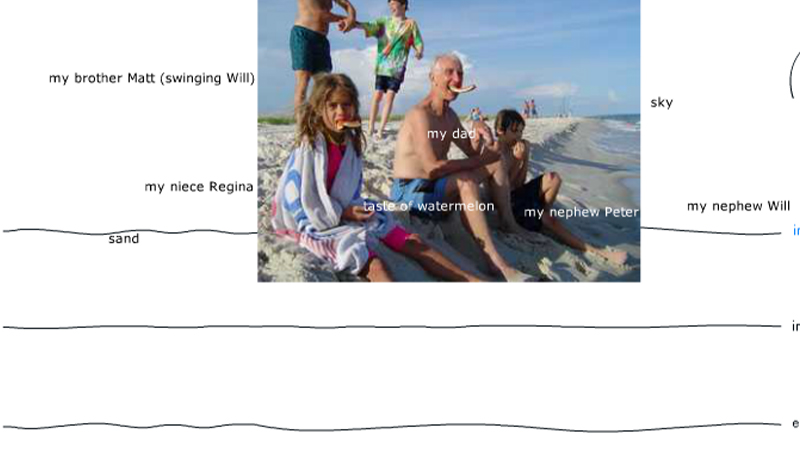In "Enfolding and Unfolding: An Aesthetics for the Information Age," Laura Marks pushes "past the surface of the screen, beyond the image, and, indeed, beyond the material world that surrounds us, [challenging] us to imagine an aesthetics that no longer need fixate on representation. Rather, she insists on an aesthetics better suited to the digital era, an aesthetics of information that expands beyond the contours of the perceptible world toward the realms of information that so underpin almost all of contemporary experience. Drawing on Charles Sanders Peirce's triadic epistemology, she offers us a tripartite mode of analysis in which experience, information and image function as planes of immanence, a conceptual framework that helps us to understand the dynamic, mutable relationship between these interlocking dimensions. Experience is the most expansive of these planes, as all information and all images unfold from (and are, in turn, enfolded in) experience. As Marks observes, 'Experience is a vast archive whose contents are almost entirely enfolded.'
Marks' goal in creating an aesthetics of enfolding and unfolding is to analyze more precisely the ways in which artworks and other objects facilitate (or perhaps inhibit) the movement between experience, information, and image. In effect, she is crafting a dynamic aesthetic model that begs for an equally dynamic implementation; her very writing pulsates and vibrates, folding in upon itself in an effort to capture the constant mobility she seeks to theorize. Enter designer Raegan Kelly. In this piece, Kelly's elegant animations help distill and enact the abstract contours of Marks' theory, percolating them into a new realm of experience without reducing their complexity. At one level, the piece functions as a translation of Marks' writing into a time-based, animated process, perhaps integrating 'form' and 'content' to a lesser degree than many Vectors' projects. Yet the ability to inhabit the diagram allows a new understanding of Marks' work to unfold, operating on different sensory and epistemological registers. The aesthetic model presented here 'privileges performativity over representation,' process over product. In the collision of text and animation (and in the gray boxes that illustrate the lines of communication between Marks and Kelly during the construction of the piece), we come to see the process of enfolding-unfolding in its dynamism.
It is important to observe that, in sketching this analytical model, Marks does not divorce the aesthetic from the political. In fact, she locates her project within a materialist framework that recognizes that 'power lies in the ability to make things unfold, circulate, and enfold.' As she illustrates, such an analysis begins to explain the function of surveillance or the circulation of capital in an electronic era, elements of experience that impact us all yet typically escape our theories of representation. In offering up this interpretative diagram, Marks and Kelly ask us to perceive the image differently." – Vectors Journal Editorial Staff
1 COPY IN THE NEXT
Published in Winter, 2007 by Vectors in Volume 2, Issue 2.
This copy was given to the Electronic Literature Lab by Erik Loyer in November of 2021.
PUBLICATION TYPE
Online Journal
COPY MEDIA FORMAT
Web


